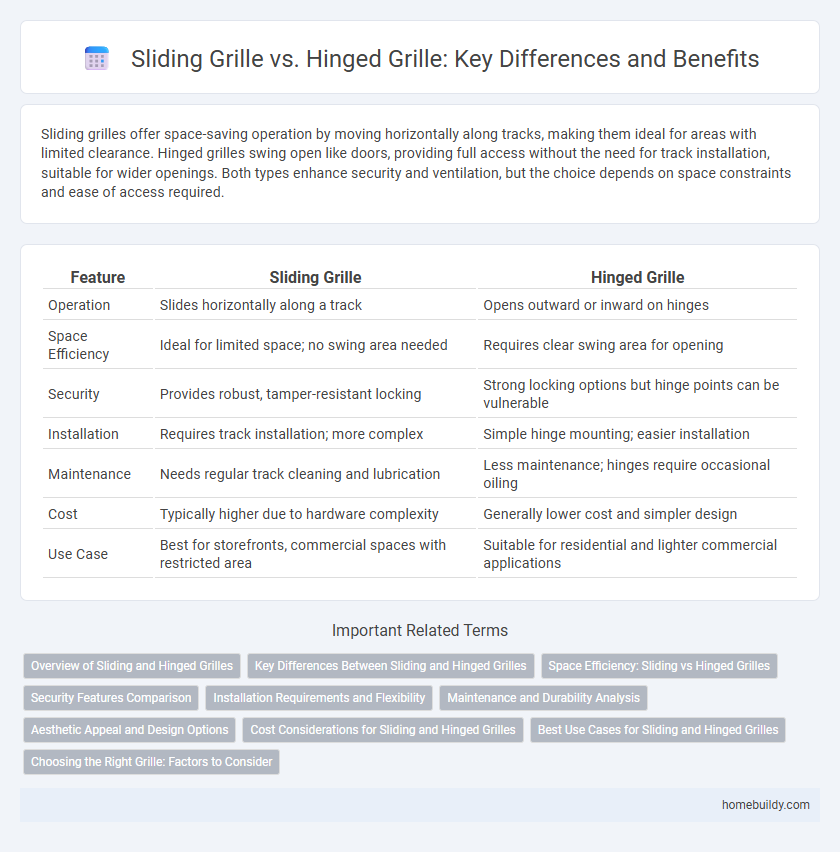Sliding grilles offer space-saving operation by moving horizontally along tracks, making them ideal for areas with limited clearance. Hinged grilles swing open like doors, providing full access without the need for track installation, suitable for wider openings. Both types enhance security and ventilation, but the choice depends on space constraints and ease of access required.
Table of Comparison
| Feature | Sliding Grille | Hinged Grille |
|---|---|---|
| Operation | Slides horizontally along a track | Opens outward or inward on hinges |
| Space Efficiency | Ideal for limited space; no swing area needed | Requires clear swing area for opening |
| Security | Provides robust, tamper-resistant locking | Strong locking options but hinge points can be vulnerable |
| Installation | Requires track installation; more complex | Simple hinge mounting; easier installation |
| Maintenance | Needs regular track cleaning and lubrication | Less maintenance; hinges require occasional oiling |
| Cost | Typically higher due to hardware complexity | Generally lower cost and simpler design |
| Use Case | Best for storefronts, commercial spaces with restricted area | Suitable for residential and lighter commercial applications |
Overview of Sliding and Hinged Grilles
Sliding grilles offer a space-saving solution with panels that glide horizontally along tracks, ideal for areas requiring frequent access and minimal obstruction. Hinged grilles operate on a pivot mechanism, swinging open like a door to allow secure entry or exit, suitable for applications demanding strong locking capabilities. Both types provide durable security while enhancing ventilation and visibility in commercial and residential settings.
Key Differences Between Sliding and Hinged Grilles
Sliding grilles operate on a track system allowing horizontal movement, ideal for space-saving and easy access in commercial settings, while hinged grilles swing open on hinges providing a wider clearance and easier manual operation. Sliding grilles offer continuous coverage and are often preferred in storefront security due to their compact retraction, whereas hinged grilles are favored for emergency exits or areas requiring rapid access. Maintenance-wise, sliding grilles require regular track cleaning to ensure smooth operation, whereas hinged grilles demand periodic hinge lubrication and alignment checks.
Space Efficiency: Sliding vs Hinged Grilles
Sliding grilles maximize space efficiency by gliding parallel to the wall, eliminating the need for clearance to swing open, making them ideal for tight or high-traffic areas. Hinged grilles require adequate space to open fully, which can limit their placement in confined environments. This makes sliding grilles the preferred choice for optimizing accessibility and conserving usable floor area in compact spaces.
Security Features Comparison
Sliding grilles offer enhanced security by allowing flexible opening and closing while maintaining a continuous barrier, reducing vulnerable gaps compared to hinged grilles. Hinged grilles provide robust locking mechanisms at fixed points, but their swing-out design can create weak spots susceptible to forced entry. Sliding grilles' track-based movement supports heavier gauges and multiple locking points, elevating resistance to tampering and break-ins for commercial and residential security applications.
Installation Requirements and Flexibility
Sliding grilles require track systems for smooth horizontal movement, demanding precise alignment and space for the tracks, which can complicate installation in confined areas. Hinged grilles offer more installation flexibility, as they attach directly to door frames or walls and swing open without the need for tracks, making them ideal for tight spaces. Both types need secure mounting, but sliding grilles are better suited for wide openings, while hinged grilles perform well in narrower or irregular spaces.
Maintenance and Durability Analysis
Sliding grilles offer easier maintenance due to their ability to be moved horizontally, allowing better access for cleaning and repairs compared to hinged grilles, which require full opening space. Hinged grilles tend to have more durable hinge mechanisms but are prone to wear and tear over time from frequent swinging movements, potentially requiring more frequent lubrication or hinge replacement. The choice between sliding and hinged grilles should consider the specific environmental conditions and frequency of use to optimize long-term performance and reduce maintenance costs.
Aesthetic Appeal and Design Options
Sliding grilles offer a sleek, modern aesthetic with clean lines and seamless integration, making them ideal for contemporary spaces seeking minimal visual interruption. Hinged grilles provide a classic, traditional look and allow for decorative customization with ornate patterns and finishes that enhance architectural detail. Design options for sliding grilles emphasize functionality and space-saving, while hinged grilles prioritize ornamental versatility and ease of access.
Cost Considerations for Sliding and Hinged Grilles
Sliding grilles generally have higher initial installation costs due to their complex track systems and motorization options, while hinged grilles tend to be more affordable with simpler mechanical components. Maintenance expenses for sliding grilles can increase over time because of track wear and motor repairs, whereas hinged grilles usually require minimal upkeep. Budget planning should also account for operational frequency, as sliding grilles offer smoother automation but at a higher long-term expense compared to the manual operation of hinged grilles.
Best Use Cases for Sliding and Hinged Grilles
Sliding grilles are ideal for commercial entrances and storefronts requiring frequent access and space-saving solutions, allowing seamless opening without obstructing walkways. Hinged grilles suit smaller retail shops or service counters where full closure security is needed, offering easy installation and robust protection that swings open like a door. Both systems enhance security and visibility, with sliding grilles preferred in high-traffic areas and hinged grilles best for controlled access points.
Choosing the Right Grille: Factors to Consider
Sliding grilles offer space-saving benefits and smooth operation, ideal for areas with limited clearance, while hinged grilles provide easier access for maintenance and are better suited for wider openings. Consider factors such as installation space, frequency of use, security requirements, and ease of access when choosing between sliding and hinged grilles. Material durability and locking mechanisms also play crucial roles in selecting the optimal grille for your specific application.
sliding grille vs hinged grille Infographic

 homebuildy.com
homebuildy.com